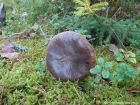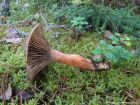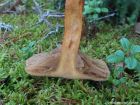Cap at first hemispherical to convex, later flattened with a faint central bump and sometimes slightly depressed. The skin is slimy in wet weather, smooth when dry, and covered with dark, appressed fibrils. Colour varies from grey-brown to cream-orange, often with cream or purplish patches, and sometimes entirely wine-red. Gills distant, descending along the stem, with short gilllets at the cap margin; initially yellow-orange, becoming darker to grey-olive and finally dark brown due to spore deposit. Stem cylindrical, more or less tapering at the base, wrinkled, creamy-pink with wine-red spots; greyish at the base with yellow-ochre mycelium. Young specimens may show a fleeting partial veil on the margin of the cap, but the ring zone is almost absent. Flesh firm, whitish-cream in the cap, yellow-orange in the stem, and grey-blackish at the stem base; smell and taste not distinctive. Spore print darkish.
Microscopic Features: Spindle-shaped, dextrinoid, 18–21 × 6–7 µm; basidia 2–4-spored, club-shaped, 45–60 × 5–6 µm; cystidia cylindrical-clavate, covered with mucus or incrustations, rounded at the tip and ending in a long, narrow stalk, 75–165 × 15–20 µm.
Many mushrooms are poisonous, and some can be lethally toxic. Distinguishing between edible and poisonous mushrooms can be very challenging. Therefore, we strongly advise against consuming wild mushrooms. This website does not contain any information about the edibility or toxicity of mushrooms.
Although efforts have been made to ensure accuracy on this website, the information may contain errors and omissions. Therefore, all content provided is for educational and informational purposes only and should not be relied upon or used as a basis for consuming any plants or mushrooms.
External links are provided for reference only. We do not endorse or take responsibility for the content, advice, or products found on these sites or in any advertisements shown on this website.




